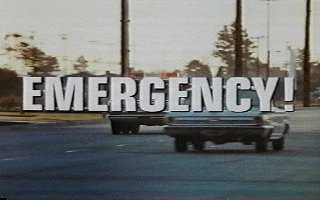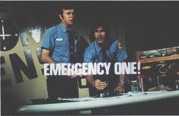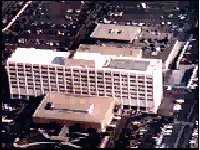
 Premise: The show centers
around Station 51 and Rampart Emergency Hospital. Station 51 contains a squad and an
engine (the station has had both a Crown and a Ward LaFrance) with a normal crew of six,
two of which are paramedics. The show begins with the pilot movie showing the paramedic
program in its infancy, before legislation is in effect to allow the paramedics to
function independently. It follows the characters of paramedics John Gage and Roy
DeSoto to the point when they are promoted to captain. Most episodes were split between
rescue scenes in "the field" and follow-up treatment at the hospital afterward.
Premise: The show centers
around Station 51 and Rampart Emergency Hospital. Station 51 contains a squad and an
engine (the station has had both a Crown and a Ward LaFrance) with a normal crew of six,
two of which are paramedics. The show begins with the pilot movie showing the paramedic
program in its infancy, before legislation is in effect to allow the paramedics to
function independently. It follows the characters of paramedics John Gage and Roy
DeSoto to the point when they are promoted to captain. Most episodes were split between
rescue scenes in "the field" and follow-up treatment at the hospital afterward.

Just the facts: Emergency! originally aired between 1972 and 1977 on
NBC. It consisted of 132 one-hour episodes with one two-hour pilot movie, and four
two-hour sequel movies. It was mostly filmed in the Los Angeles area (The movies were
filmed in Seattle and San Francisco). In reality, Fire Station 106 was the original
station chosen for filming the show but it faced North (and would throw shadows) so
Station 127 was used instead. The syndicated episodes were apparently retitled Emergency One!
to avoid confusion.
 Many episodes dealt with actual events in
an attempt to educate, as well as entertain, the public. The format of the show (dividing
the episodes between rescue scenes and hospital scenes) was due to the expense
of filming rescue scenes, while the hospital scenes were relatively inexpensive
-- so by
splitting the episode between the hospital and the field, the production company saved
money.
Many episodes dealt with actual events in
an attempt to educate, as well as entertain, the public. The format of the show (dividing
the episodes between rescue scenes and hospital scenes) was due to the expense
of filming rescue scenes, while the hospital scenes were relatively inexpensive
-- so by
splitting the episode between the hospital and the field, the production company saved
money.
The exterior of Rampart Hospital was
actually Harbor UCLA Medical Center, located
in Torrance, California.
 The show starred Robert Fuller as Dr. Kelly
Brackett, Julie London as
Dixie McCall, Bobby Troup as
Dr. Joe Early, Kevin Tighe as
Roy DeSoto, and Randolph
Mantooth as John Gage. The director/producer of the show was Jack Webb and the executive
producer was Robert Cinader.
The show starred Robert Fuller as Dr. Kelly
Brackett, Julie London as
Dixie McCall, Bobby Troup as
Dr. Joe Early, Kevin Tighe as
Roy DeSoto, and Randolph
Mantooth as John Gage. The director/producer of the show was Jack Webb and the executive
producer was Robert Cinader.
During the run of the show, the Los
Angeles County F.D. promoted the paramedic program and the new Ward LaFrance engine in a
4000-mile tour from New York to West Coast studio. You can read more about it in
Dick Friend's A Nation Viewed by a Pumper.

"Emergency!"
ABOUT THE PRODUCTION
"To suffer fifty weeks of the year for the sake of a two-week vacation; it's a
measly manner of existence." These are the feelings expressed by a character in
Arthur Miller's mult-award winning play, "Death of a Salesman."
Fortunately, members of paramedics emergency rescue teams don't feel this way,
for the know that they are members of an exciting, rewarding, although sometimes
dangerous, profession.
Their way of life constitutes the main strength of Universal Television's
hour-long series "Emergency!", which begins it's fourth season on the NBC
Television Network on Saturday, September 14.
Not only has "Emergency!" proven successful and popular television viewing, it's
graphic illustration of society's need for trained paramedics, has in the words
of Senator Alan Cranston "…alerted the public to the value of paramedic for
better emergency care."
In September, 1972, the Senator wrote to Jack Webb, whose Mark VII Ltd. produces
the series to say… We unanimously passed a bill that, among other things would
promote the training of paramedics to staff ambulances and emergency rooms in
hospitals across the country. I introduced the provisions in the bill dealing
with paramedics and emergency medical services in hopes that our nation will
make greater use of the thousands of experienced, able young men who have
returned from Vietnam with the medical skills America needs so desperately. They
are to get top priority in the training programs. Jack, your "EMERGENCY!"
series fired the public imagination and was the harbinger for a medical idea
whose time, I believe, has come. In the midst of a severe shortage of doctors,
nurses and trained emergency personnel, 175,000 die each year because they do
not get adequate medical care in an emergency. Another 25,000 are left
permanently disabled because of inept handling by untrained ambulance
attendants. "EMERGENCY!" has dramatized the potential of the paramedic. I hope
the House of Representatives and the President will now follow the lead of 100
Senators -- and Jack Webb! Thank you for the good work, Jack. And
congratulations to you and all the people connected with "EMERGENCY!"
The background of "Emergency!" as a television series is the true story of a
project that began in Los Angeles in 1969, the year that launched a specially
trained team of highly skilled firemen-paramedics to operate rescue squads for
the L.A. County Fire Department. Although many fire departments traditionally
have provided rescue service to aid the injured, sick and dying, it was obvious
to many civic officials and medical personnel that too many patients were being
lost before they could receive trained medical aid at the hospital.
The initial program to alleviate this waste of life was inaugurated, funded by
the federal and county governments. In pairs, the firefighters went with doctors
on their daily hospital rounds, checking vital signs, taking blood pressure
readings, interpreting electrocardiograms. The performed as "student medical
assistants".
r2pbet casino. blackjack juego online.
Afternoons were spent in the classrooms, where the firemen and a score of
registered nurses qualified to become Cardiac Care Unit Specialist.
Three short months later, the firemen were in the fields, able to put their
newly acquired knowledge to use with the aid of sophisticated, and expensive,
mobile equipment which was added to the conventional rescue squad trucks.
For the first year, a nurse accompanied the paramedics on all calls because
there was no legal authority for the firemen to perform the advanced techniques
they had learned. Then, the Wedworth-Townsend Act was passed by the California
State Legislature and the paramedic program was off the ground.
Jack Webb has been blazing new trails in dramatic programs for more than 20
years. He films "Emergency!" with the full cooperation and assistance of the Los
Angeles County Fire Department as well as the County Department of Hospitals.
Adding a decidedly realistic touch, authentic fire-fighting equipment has been
loaned to the production company. Should any of it be needed in an actual
crisis, a "hot line" links fire department headquarters to the sound stage. One
ring on that instrument, appropriately painted fire engine red, and film
production becomes secondary to the needs of the community.
As the series begins it's fourth season, Robert A Cinder remains as executive
producer. Robert Fuller, Julie London, Bobby Troup, Randolph Mantooth and Kevin
Tighe, heading the star line-up, continue to keep the viewing audiences
entertained.
I believe this came from a public
release that a fan sent us, but I'm sorry, I'm not sure.

Note from Richard Yokley:
Before there was "Emergency!" there was "Emergency."
Note the missing "!" In Australia in 1959 there was a TV series titled
Emergency that featured primarily the Doctors and nurses in a hospital along
with guys in an ambulance. The episodes would open with a vehicle accident
or medical emergency with the ambulance crew responding, treating, picking them
up and bringing them back to the hospital for treatment where the balance of the
live on film, kinescope, took place. The 30 minute episodes were quite poplar at
the time.